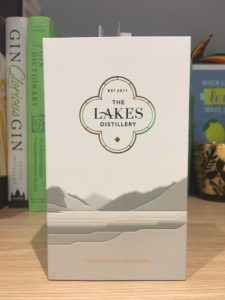 As we enter week two of Ginvent, we start with something special. We were lucky enough to get tickets to an evening with Capreolus Distillery at Gin Foundry HQ as part of their Summer Series and it was eye opening. Barney, who can talk more than I can, introduced us to his extensive range of products, starting with their most recognisable Garden Swift dry gin, before we moved onto some of the aged gins and eau de vies (which is an incredibly big collection). Today’s gin is from their rare Hart & Dart gin, so good it gets it own name rather than just a barrel aged edition. They start with the Garden Swift gin (which, FYI, came about by hundreds of individual distillations and blends to ensure they were getting the exact mix they were looking for), known for it’s bold fresh Sicilian orange and British lime leaves is then aged in rare mulberry wood barrels. This gin is released in single batches which each has it’s own character from the wood – mulberry adds a sweetness, a spice note and a hint of florals. This sweetness, they say, brings in notes of apricot on top of the 34 carefully picked botanicals already in the gin. They also recommend it in place of an Old Tom gin in cocktails (due to the sweetness), or in a classic negroni thanks to its complexity. So, how does it taste?
As we enter week two of Ginvent, we start with something special. We were lucky enough to get tickets to an evening with Capreolus Distillery at Gin Foundry HQ as part of their Summer Series and it was eye opening. Barney, who can talk more than I can, introduced us to his extensive range of products, starting with their most recognisable Garden Swift dry gin, before we moved onto some of the aged gins and eau de vies (which is an incredibly big collection). Today’s gin is from their rare Hart & Dart gin, so good it gets it own name rather than just a barrel aged edition. They start with the Garden Swift gin (which, FYI, came about by hundreds of individual distillations and blends to ensure they were getting the exact mix they were looking for), known for it’s bold fresh Sicilian orange and British lime leaves is then aged in rare mulberry wood barrels. This gin is released in single batches which each has it’s own character from the wood – mulberry adds a sweetness, a spice note and a hint of florals. This sweetness, they say, brings in notes of apricot on top of the 34 carefully picked botanicals already in the gin. They also recommend it in place of an Old Tom gin in cocktails (due to the sweetness), or in a classic negroni thanks to its complexity. So, how does it taste?
review
Ginvent 2019 – Rock Rose Pink Grapefruit gin
 We’ve made it to the end of week one, hurrah! Just two and a bit left. Today’s gin is from Rock Rose, a Scottish brand with some beautiful bottles. I’ve tried their original gin a few times out and about, and their Winter gin was included in the 2017 calendar. Made in Dunnet Bay Distillery (who also do a lot of contract distilling) they have three key flavours, plus four seasonal editions. In their main range they have their original gin, a navy strength gin, and today’s drink: the pink grapefruit Old Tom gin. This excites me because I love pink grapefruit, and I love Old Tom gins. As you should know, an Old Tom style gin is traditionally sweeter than normal gin (legend has it that back in the illicit gin trade days, people would add turpentine and such to their mix so would throw in a load of sugar to hide the taste) and the Rock Rose team add muscovado sugar at the end of the process. Before this, they hand peel organic pink grapefruits which are hung in a basket and vapour infused during the distillation. This gin was originally a limited edition run in 2016 during a competition for artists to design them a new label. The demand for this was so high that they went on to tweak the recipe slightly and bring it back in the core offering in 2019. So, let’s give it a try!
We’ve made it to the end of week one, hurrah! Just two and a bit left. Today’s gin is from Rock Rose, a Scottish brand with some beautiful bottles. I’ve tried their original gin a few times out and about, and their Winter gin was included in the 2017 calendar. Made in Dunnet Bay Distillery (who also do a lot of contract distilling) they have three key flavours, plus four seasonal editions. In their main range they have their original gin, a navy strength gin, and today’s drink: the pink grapefruit Old Tom gin. This excites me because I love pink grapefruit, and I love Old Tom gins. As you should know, an Old Tom style gin is traditionally sweeter than normal gin (legend has it that back in the illicit gin trade days, people would add turpentine and such to their mix so would throw in a load of sugar to hide the taste) and the Rock Rose team add muscovado sugar at the end of the process. Before this, they hand peel organic pink grapefruits which are hung in a basket and vapour infused during the distillation. This gin was originally a limited edition run in 2016 during a competition for artists to design them a new label. The demand for this was so high that they went on to tweak the recipe slightly and bring it back in the core offering in 2019. So, let’s give it a try!
Ginvent 2019 – Slingsby Gooseberry gin
 Today’s gin is becoming a staple in the Ginvent calendars; in 2016 we tried Slingsby gin, in 2017 we tried their rhubarb gin, and today we try their gooseberry edition. A proud Yorkshire business, Slingsby gin started in 2015 and since their launch have developed six spirits in their main collection. Alongside the two we have already tried, they have a navy strength gin, a marmalade gin and a vodka. The gooseberry gin, in a beautiful green bottle, still uses their famous Harrogate water alongside their base spirit and locally sourced botanicals. Their Yorkshire-grown gooseberries are packed with vitamin C (so this is good for you, right?) and impart a burst of sharpness, that they say is balanced by the sweet citrus of their classic gin. So, how does it taste? Continue reading
Today’s gin is becoming a staple in the Ginvent calendars; in 2016 we tried Slingsby gin, in 2017 we tried their rhubarb gin, and today we try their gooseberry edition. A proud Yorkshire business, Slingsby gin started in 2015 and since their launch have developed six spirits in their main collection. Alongside the two we have already tried, they have a navy strength gin, a marmalade gin and a vodka. The gooseberry gin, in a beautiful green bottle, still uses their famous Harrogate water alongside their base spirit and locally sourced botanicals. Their Yorkshire-grown gooseberries are packed with vitamin C (so this is good for you, right?) and impart a burst of sharpness, that they say is balanced by the sweet citrus of their classic gin. So, how does it taste? Continue reading
Ginvent 2019 – Loch Ness gin
 Fans of the blog might have read my review of Loch Ness gin nearly two years ago, and today we are revisiting this for day five of Ginvent! You can read my original thoughts here.
Fans of the blog might have read my review of Loch Ness gin nearly two years ago, and today we are revisiting this for day five of Ginvent! You can read my original thoughts here.
Ginvent 2019 – Tarquin’s Treth Ha Mog Gin
 Ginvent means one thing: a Tarquin’s exclusive! Pairing up with team Gin Foundry for the third time (first was the Hedgerow gin, second was last year’s Tan Ha Mor), they kept fairly shtum about what exactly is involved, but luckily months of Instagram stalking (and a few conversations with Emile and Olivier) plus their release a few weeks ago mean we know a bit about this now. They wanted to really invoke the sense of Cornwall of barbecues on the beach (which TBH is summer in most coastal areas, Brighton included). Pictures from their Instagrams show the team on the beach with trays of woodchips, and they have said they threw everything on – sea samphire, fennel, saffron, spiced butter and, I kid you not, lobster. Whacked on a few extra lemons and let it all char and griddle to get a real sense of candied fruit and smoked wood and the job is a good’un. This mixture of non-veggie friendly goodness was then throw in the the pot to be distilled. So, let’s see how it tastes.
Ginvent means one thing: a Tarquin’s exclusive! Pairing up with team Gin Foundry for the third time (first was the Hedgerow gin, second was last year’s Tan Ha Mor), they kept fairly shtum about what exactly is involved, but luckily months of Instagram stalking (and a few conversations with Emile and Olivier) plus their release a few weeks ago mean we know a bit about this now. They wanted to really invoke the sense of Cornwall of barbecues on the beach (which TBH is summer in most coastal areas, Brighton included). Pictures from their Instagrams show the team on the beach with trays of woodchips, and they have said they threw everything on – sea samphire, fennel, saffron, spiced butter and, I kid you not, lobster. Whacked on a few extra lemons and let it all char and griddle to get a real sense of candied fruit and smoked wood and the job is a good’un. This mixture of non-veggie friendly goodness was then throw in the the pot to be distilled. So, let’s see how it tastes.
Ginvent 2019 – Pickering’s Brussels Sprout gin
 It’s day three of Ginvent and we’ve hit our first strange gin – Pickering’s limited edition Brussels sprout gin. To celebrate the Christmas season, they have released six festive flavours: cranberry, figgy pudding, plum & ginger, spiced pear & cinnamon, clementine, and today’s flavour Brussels sprout. Using their classic gin as the base spirit, they distil their gin in their copper still Gertrude and they say this results in a herbaceous finish with bright green pepper notes. Matt, the co-founder and head distiller at Pickering’s, found 10,000 sprouts in January to make this gin, which shows how long in the making a new gin flavour can be. Mixed with classic tonic, they suggest adding a slice of cucumber as a garnish, or making it into their “love it or hate it” cocktail with fresh cucumber, lime, orange bitters and elderflower tonic.
It’s day three of Ginvent and we’ve hit our first strange gin – Pickering’s limited edition Brussels sprout gin. To celebrate the Christmas season, they have released six festive flavours: cranberry, figgy pudding, plum & ginger, spiced pear & cinnamon, clementine, and today’s flavour Brussels sprout. Using their classic gin as the base spirit, they distil their gin in their copper still Gertrude and they say this results in a herbaceous finish with bright green pepper notes. Matt, the co-founder and head distiller at Pickering’s, found 10,000 sprouts in January to make this gin, which shows how long in the making a new gin flavour can be. Mixed with classic tonic, they suggest adding a slice of cucumber as a garnish, or making it into their “love it or hate it” cocktail with fresh cucumber, lime, orange bitters and elderflower tonic.
Ginvent 2019 – Dartmouth Navy Strength gin
 Day two of Ginvent brings me something I’m rather excited for. Last year we tried Dartmouth gin for the first time, and I am a big fan. Today, we are trying their navy strength version. Their original gin mixes juniper with floral and spiced notes, and the navy strength version uses a new recipe as well as the new ABV of 57%. The Naval link is deeply ingrained in the brand, their families having centuries of maritime history and this gin takes that inspiration a step further. They amp up the juniper and bring lime in at the front – presumably to fight off the scurvy – alongside loads of spice power from grains of paradise, star anise, cardamom and cubeb.
Day two of Ginvent brings me something I’m rather excited for. Last year we tried Dartmouth gin for the first time, and I am a big fan. Today, we are trying their navy strength version. Their original gin mixes juniper with floral and spiced notes, and the navy strength version uses a new recipe as well as the new ABV of 57%. The Naval link is deeply ingrained in the brand, their families having centuries of maritime history and this gin takes that inspiration a step further. They amp up the juniper and bring lime in at the front – presumably to fight off the scurvy – alongside loads of spice power from grains of paradise, star anise, cardamom and cubeb.
Ginvent 2019 – Conniption Navy Strength Gin
 Happy first day of Ginvent! Here we are for my fourth year and kicking off the festivities with Conniption Navy Strength gin. Hailing from the Durham Distillery, this gin isn’t from the Durham of Cathedral fame, instead they are based in Durham, North Carolina. We’ll take a short detour here to talk about American gins as they have some different rules over the sea. Here in the UK, to be gin the flavour must be “predominantly” juniper with a minimum ABV of 37.5%. In the USA, gins have to be “characteristically” juniper and a minimum of 40% ABV. This means their gins have a different feel as the juniper is less obvious (at least in the American gins I’ve tried previously) which allows them to play with their flavour profile a bit more. Now we have that out the way, the distillery uses a two step process to create their gins. First they perform a traditional distillation in a copper pot, then they move on to a more modern vacuum distillation for their more delicate botanicals. Their original gin uses cucumber and honeysuckle to create a fresh and floral finish, and usually when a brand creates a navy strength gin they tend to just amp up their recipe. Here, they share just three botanicals but add sweet citrus and fig and raises the ABV to 57%. They have won a number of awards, most recently winning the Best American Navy Strength gin at the 2019 World Gin Awards and before that a double gold (pretty impressive) at the 2017 San Francisco World Spirits Competition. So, how does it taste?
Happy first day of Ginvent! Here we are for my fourth year and kicking off the festivities with Conniption Navy Strength gin. Hailing from the Durham Distillery, this gin isn’t from the Durham of Cathedral fame, instead they are based in Durham, North Carolina. We’ll take a short detour here to talk about American gins as they have some different rules over the sea. Here in the UK, to be gin the flavour must be “predominantly” juniper with a minimum ABV of 37.5%. In the USA, gins have to be “characteristically” juniper and a minimum of 40% ABV. This means their gins have a different feel as the juniper is less obvious (at least in the American gins I’ve tried previously) which allows them to play with their flavour profile a bit more. Now we have that out the way, the distillery uses a two step process to create their gins. First they perform a traditional distillation in a copper pot, then they move on to a more modern vacuum distillation for their more delicate botanicals. Their original gin uses cucumber and honeysuckle to create a fresh and floral finish, and usually when a brand creates a navy strength gin they tend to just amp up their recipe. Here, they share just three botanicals but add sweet citrus and fig and raises the ABV to 57%. They have won a number of awards, most recently winning the Best American Navy Strength gin at the 2019 World Gin Awards and before that a double gold (pretty impressive) at the 2017 San Francisco World Spirits Competition. So, how does it taste?
Lakes gin
Note: The team at The Lakes Distillery sent me a sample of their new recipe to try, but as always I’ll let you know what I really think.
 Back in February 2017, I was sent a sample of Lakes gin to try. Then, on my 30th birthday (10 October 2019 FYI) I received an email from the team saying they had reworked the recipe and had a beautiful rebrand to boot. After launching their single malt whisky, they have looked back at their gin and worked on it to ensure it stands the test of time. They’ve adopted a ‘less is more’ approach and now take a British wheat spirit as their base, and infuse in this their new range of botanicals; juniper and coriander are bound with angelica, orris root, cassia bark and liquorice before finishing with orange and lemon peel. They steep these in the spirit overnight to release the essential oils before distilling their gin in a copper pot still. Their rebrand reminds me of Mermaid gin, which was a great product in a fairly bland bottle; they get a jazzy new bottle and suddenly everyone takes notice. The new Lakes gin bottle features a new, leaner shape, an engraved glass bottle and a new label. The new recipe has also ramped up the ABV from 43.7% to 46%, hopefully ensuring the juniper is still front and centre. So, how does it compare?
Back in February 2017, I was sent a sample of Lakes gin to try. Then, on my 30th birthday (10 October 2019 FYI) I received an email from the team saying they had reworked the recipe and had a beautiful rebrand to boot. After launching their single malt whisky, they have looked back at their gin and worked on it to ensure it stands the test of time. They’ve adopted a ‘less is more’ approach and now take a British wheat spirit as their base, and infuse in this their new range of botanicals; juniper and coriander are bound with angelica, orris root, cassia bark and liquorice before finishing with orange and lemon peel. They steep these in the spirit overnight to release the essential oils before distilling their gin in a copper pot still. Their rebrand reminds me of Mermaid gin, which was a great product in a fairly bland bottle; they get a jazzy new bottle and suddenly everyone takes notice. The new Lakes gin bottle features a new, leaner shape, an engraved glass bottle and a new label. The new recipe has also ramped up the ABV from 43.7% to 46%, hopefully ensuring the juniper is still front and centre. So, how does it compare?
Wessex Alfred the Great Gin
 It’s September which means it is Craft Gin Club delivery time again! This month’s gin comes from Wessex Gin (along with a host of goodies including my fave cardamom tonic from Peter Spanton). Gin distilling is not a new venture for the founder of Wessex Gin, Jonathan Clark. Jonathan was the founder of the City of London Distillery (about 5 mins from my office, see my thoughts on the Six Bells gin and Square Mile gin) and when retirement didn’t suit him, he and his family decided to start all over again. The City of London Distillery is so ingrained in London, and when Jonathan and wife Gill moved to Wessex, they wanted that same connection to their surroundings. Having grown up in the countryside of Hampshire, we visited many a Roman/Saxon/Tudor sites thanks to school trips, and it’s this Anglo-Saxon time that inspired this gin. Specifically, the stories of King Alfred the Great, the man that scared off the Vikings (which was no mean feat). This era embraced the magic and the mystic, herbs were used for their healing properties and this has never really faded in the gin industry with a strong focus on the roots of their botanicals. The Anglo-Saxons were big on herbariums – a book listing herbs and their properties – and it is this that the Clark’s used to source their botanicals. Keen to make a classic London Dry gin which is heavy on the juniper, Jonathan also favours citrus led gins, with a hint of coriander and medicinal chervil, nowadays bringing an aniseed quality but also reportedly soothing stomach ailments – did you know King Alfred suffered from stomach problems with people thinking it was akin to Crohn’s Disease. So, how does it taste?
It’s September which means it is Craft Gin Club delivery time again! This month’s gin comes from Wessex Gin (along with a host of goodies including my fave cardamom tonic from Peter Spanton). Gin distilling is not a new venture for the founder of Wessex Gin, Jonathan Clark. Jonathan was the founder of the City of London Distillery (about 5 mins from my office, see my thoughts on the Six Bells gin and Square Mile gin) and when retirement didn’t suit him, he and his family decided to start all over again. The City of London Distillery is so ingrained in London, and when Jonathan and wife Gill moved to Wessex, they wanted that same connection to their surroundings. Having grown up in the countryside of Hampshire, we visited many a Roman/Saxon/Tudor sites thanks to school trips, and it’s this Anglo-Saxon time that inspired this gin. Specifically, the stories of King Alfred the Great, the man that scared off the Vikings (which was no mean feat). This era embraced the magic and the mystic, herbs were used for their healing properties and this has never really faded in the gin industry with a strong focus on the roots of their botanicals. The Anglo-Saxons were big on herbariums – a book listing herbs and their properties – and it is this that the Clark’s used to source their botanicals. Keen to make a classic London Dry gin which is heavy on the juniper, Jonathan also favours citrus led gins, with a hint of coriander and medicinal chervil, nowadays bringing an aniseed quality but also reportedly soothing stomach ailments – did you know King Alfred suffered from stomach problems with people thinking it was akin to Crohn’s Disease. So, how does it taste?